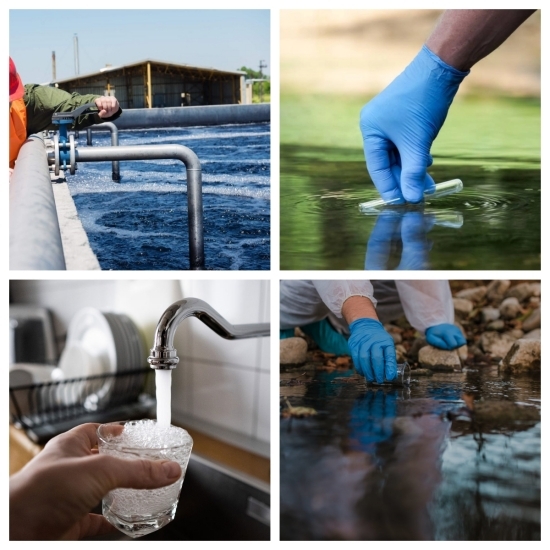A water quality detector is a device used to detect and analyze various components in water and evaluate water quality. They use various sensors, probes, and analytical techniques to measure the physical properties, chemical composition, and biological parameters in water to determine the health and suitability of the water body and to assess whether the water quality meets specific standards or requirements.
The main functions of a water quality and testing include measuring biological oxygen demand (BOD), chemical oxygen demand (COD), pH, conductivity, turbidity, total dissolved solids (TDS), and other items in water. These measurements are essential for evaluating the safety and suitability of water. Water tests not only improve the accuracy and efficiency of detection but also provide more functions and application scenarios, providing more powerful technical support for water quality monitoring and management.
What Scenarios Can Water Quality Testers Be Used In?
The water quality testers currently provided by SISCO online stores can basically meet most of your usage needs. With its advanced sensors, water quality testers can ensure the accuracy and reliability of measurement results. In addition, the water quality tester is small in size and light in weight, which is convenient to carry to different testing locations. It is suitable for field sampling and on-site testing. It has an intuitive operation interface and simple operation steps and can obtain test results in a short time. It is suitable for a variety of different usage scenarios.

Environmental monitoring
At environmental protection monitoring stations or environmental protection departments, water quality testers are required to regularly test the quality of rivers, lakes, groundwater, and other water bodies to ensure that they meet national environmental protection standards.
Industrial production
In industries such as electricity, chemical industry, and medicine, the quality of industrial water will directly affect product quality and safety. It is very important for the quality of industrial wastewater, process water, and circulating water, and it is also related to controlling the production process and protecting the environment.
Scientific research and education
In water quality-related research, educational and scientific research institutions such as colleges and universities, research institutes, etc., also need to use water quality testers to collect experimental data to help students better understand and master the relevant knowledge and skills of water quality testing.
Agriculture and fisheries
It is used to detect the quality of irrigation water, aquaculture water, and fish pond water, and maintain a good environment for agricultural and fishery production. Especially in aquaculture, water quality testers are used to monitor indicators such as dissolved oxygen, ammonia nitrogen, and nitrite in water to maintain a healthy growth environment for aquatic organisms.
Working principle of water quality detector
The working principle of water tester meters is based on different measurement technologies and sensors. Common measurement technologies include electrochemical methods, optical methods, chromatography, fluorescence methods, etc. Each technology has specific sensors or probes for measuring different indicators in water, such as pH value, dissolved oxygen, conductivity, turbidity, residual chlorine, ammonia nitrogen, etc. These sensors measure specific properties or reactions of target substances in water by contacting or immersing in water samples and then convert the measurement results into numerical display or output. The following is a brief introduction to common detection technologies.
pH value is mainly measured by a pH sensor (usually a glass electrode) The concentration of hydrogen ions in water. The electrolyte in the sensor reacts with the hydrogen ions in the water sample to produce a potential difference, which is proportional to the pH value, that is, the pH electrode is immersed in the water sample and converted to the pH value through the potential difference.
Conductivity is the measurement of the ion content in the water sample, and the conductivity is proportional to the concentration of dissolved ions in the water. Using a conductivity sensor, the conductivity is determined by measuring the current intensity of the water sample when a voltage is applied between the electrodes.
Dissolved oxygen (DO) is based on electrochemical or optical methods. The electrochemical method measures oxygen molecules in the water sample through electrodes, and the pH value of the solution is inferred by measuring the cell electromotive force generated by the electrode system, or the polarographic thin film electrode method is used to determine dissolved oxygen. The optical method uses the principle that light of a specific wavelength is absorbed by dissolved oxygen. The sensor is immersed in the water sample, and the dissolved oxygen concentration is calculated by the electrode reaction or light absorption.
Turbidity detection measures the degree of light scattering and absorption by the water sample. The higher the turbidity, the stronger the light scattering and absorption. Using an optical sensor, usually a light source and a detector, the light emitted by the light source passes through the water sample and is received by the detector. The turbidity is calculated by the degree of light attenuation.
Total dissolved solids (TDS) measure the total amount of all dissolved solids in the water sample, usually indirectly measured by conductivity. The detection method is similar to conductivity detection, and the TDS content is estimated by the conductivity value.
With the current intensification of environmental pollution problems and the public's increased attention to water quality safety, the demand for water quality testing will continue to grow, and the water quality testing industry will also develop rapidly. In order to meet the needs of rapid on-site testing, water quality testing instruments will be more miniaturized and portable, which will make the testing equipment easier to carry and operate, convenient for rapid testing in the field or on-site, and able to detect more water quality parameters. In the future, with the continuous development of technologies such as sensor technology, artificial intelligence, and big data analysis, water quality testing instruments will achieve a higher degree of automation and intelligence. This will improve the efficiency and accuracy of water quality testing, reduce labor costs, and promote the intelligent transformation of the water quality testing industry.

